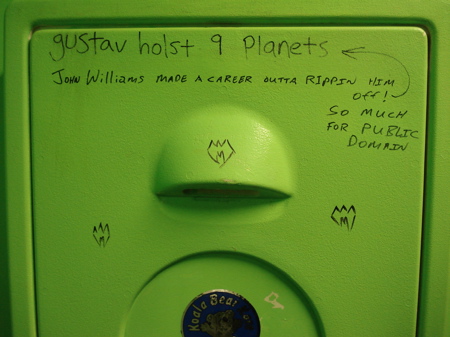
Earlier this week I noticed that a fellow patron of the JP Licks men’s restroom felt inspired to jot “Gustav Holst 9 planets” on the baby-changing table with black marker. Perhaps it was playing on his iPod as he was taking care of business and he felt compelled to leave an inscription of this sublime listening experience on the nearest wall. Now that our listening experiences happen more often while we are out and about, perhaps this is a natural impulse–to connect our music memories to places.
In fact, a exploding number of networked geo-annotation projects offer digital outlets this impulse, and as with every other nuance of networked culture, a neologism now exists to describe it:
‘placecasting ‘: networked publishing of digital media (esp. audio) that is logically associated with a physical location, to be experienced by suitably equipped people in that location.
Placecasting would allow the music lover I describe to attach Holst to the JP licks bathroom (or perhaps JP Licks more generally, to be inclusive) such that anyone else with the right networked device would be able to listen to it here.
And the social networking aspects of this digital annotation would enable allow others to satisfy their need to comment on the original post, as another patron of the bathroom did the next day:
“John Williams made a career outta ripping of him off! So much for public domain”

Comments
2 responses to “Classical Music Graffiti, or the Promise of Placecasting”
Highbrow graffiti – I guess it’s to be expected around Harvard and MIT…
Placecasting…
I am sure there are several geotagging equivalents for media files, but the only way I can think of at the moment is to use a combination of Trailfire and YouTube. Trailfire allows you to embed media in a pagelink, so that if you had a wifi web-enabled ipod, you could search on JP Licks, then choose whatever tags other people had left. Virtual graffiti, med son et lumiere!
I’ve done a trail around Durham (England) that has some embedded media. But as I said, there must be other more direct ways of doing this.